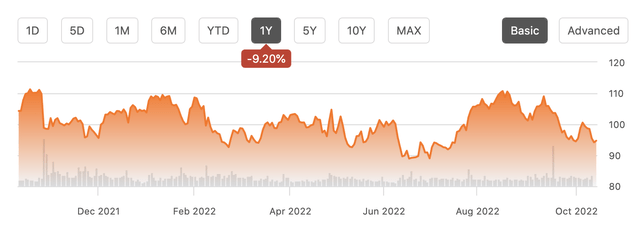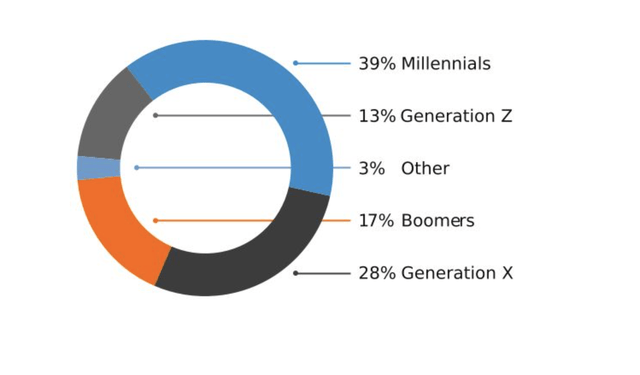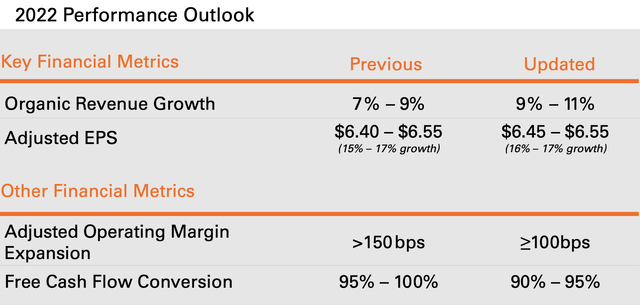MoMo Productions
Relative to many other companies in the fintech sector, Fiserv, Inc. (NASDAQ:FISV) has held up pretty well, down just 10% over the past year. FISV is a prime example of a “GARP” (growth at a reasonable price) company that can do well in this uncertain environment. While its legacy payment processing business faces competitive threats, it is on the offense with new products that are challenging new entrants like Block (SQ) and PayPal (PYPL). I think shares can return to the $110-115 area, representing up to 20% upside.
In the company’s second quarter, we see that results are strong, as the company’s First Data acquisition went smoothly with $600 million in synergies achieved well ahead of schedule. Q2 revenue was up 10% to $4.2 billion, with organic growth of 12%. As a consequence, adjusted EPS was up 14% to $1.56. One point of caution is that operating margins of 33.5% were down 40bp year-on-year. While FISV has several key growth initiatives, these may prove to be somewhat lower margin than its legacy business.
Fiserv is at its core a payment processing company. Its technology platforms enable companies to accept transaction, and for money to move among banks, customers, and businesses. It operates in three main segments. The first and most important is merchant, where FISV is enabling large and small businesses to transact, with a particular emphasis on e-commerce and digital transactions.
Merchant revenue was up 14% to $1.9 billion, representing nearly half of the company total. Volume growth was 7%, while transaction growth was 5%, a strong result considering Fidelity National Information Services, Inc. (FIS) saw a 5% sequential decline in volumes. There is a concern that traditional merchant payment networks could be disrupted by Square’s Cash App, PayPal, or even longer-term threats from decentralized finance providers or something blockchain-related. Fortunately, there was a hidden gem in Fiserv’s 2019 purchase of First Data, an app called Clover, a point-of-sale system for small and medium-sized business.
The growth has been tremendous and was up 24% year-over-year in Q2, reaching an annualized $233 billion in gross payment volumes. For comparison, PayPal’s payment volumes are over $1.2 trillion a year. While Clover is now a scaled business, there is still meaningful growth potential. Fiserv has launched Carat, a Clover lookalike, to target larger businesses, and found pairing Clover with other offerings it has – like Bento for restaurants – can lead to greater usage and up to triple the revenue.
Essentially, there is a high-growth fintech disrupter inside of an entrenched fintech player. With the scale of its existing relationships, Fiserv has been able to roll out Clover quickly and generate substantial growth. Today, Fiserv has a $63 billion market cap. Even after losing two-thirds of its value, PayPal is worth nearly $100 billion. At about 20% the size, Clover could be a $20 billion asset that is not being fully reflected in FISV’s valuation, creating room for upside as it becomes a larger piece of the business.
But Fiserv is not just disrupting merchant volumes, it is also doing so in payments. In Q2, it generated 7% revenue growth in its payments and networks group to $1.5 billion. Operating margins were down 80bp, as increased payments competition is definitely pressuring pricing. However, Fiserv isn’t letting its core business simply be competed against, it is leading the way as a key processer underneath the Zelle platform. For those unfamiliar, Zelle is owned by a consortium of the big banks to enable person-to-person cash transfers. It is essentially their answer to Venmo. As you can see, its users are generally younger Americans, with millennials the biggest cohort.
This should position the platform for continued growth, and Fiserv is a prime beneficiary. It saw 35% growth in its Zelle business. This is still just 2% of its payment business, but it is quickly growing. Last quarter, it passed 1,000 Zelle clients, with an expectation to double that in two years. The network effect should enable revenue growth to outpace client growth, and by 2025, this could be 8-10% of the business and growing. Even as the nature of financial transactions changes, Fiserv is positioning itself to be integral to the financial system of tomorrow, with key, growing offerings on business-to-consumer and consumer-to-consumer transactions.
As you can see, this led the company to raise full year guidance on the revenue front and raise the low end of its EPS guidance. As mentioned, these new offerings and increased competition have weighed on operating margins, which will expand less than once hoped. Still, it is better to sacrifice margins to position for long-term growth than try to preserve them but risk falling behind vs other fintech peers. I would also note this guidance assumes 200bp of currency headwinds going forward, worse than last quarter’s performance of -150bp, given the ongoing strength of the dollar. When the company reports Q3 earnings on October 27, I see some risk currency is a slightly bigger drag.
Fiserv did also revise down its free cash flow conversion as its Q2 conversion was just 65% at $658 million. Some of this is due to working capital, which has been a $463 million headwind year to date. Holding working capital constant, free cash flow would have been about $1.55 billion in H1. The other reason is that its cap-ex spending has risen from $500 million to over $700 million YTD. I view this as a positive, as FISV’s investments in Clover, Carat, and Zelle are driving significant growth and helping to future-proof the business. Sacrificing a bit of cash flow today to speed up those investments and build out their infrastructure is the prudent long-term move.
Plus, the company is still on track to generate about $3.5 billion of free cash flow this year. This is enabling steady share repurchases, including $500 million last quarter. It is now down to 651 million shares outstanding, down 3.3% year-over-year. It should be able to continue to reduce its share count at 3-5% per annum even with this faster pace of cap-ex.
My one negative is that the company has $21.5 billion of debt, taken on to acquire First Data. $4.8 billion of that comes due over the next two years, and $3.4 billion is floating rate. Management is primarily directing cash flow to buybacks rather than debt reduction, so, given the rise in interest rates, its interest expense could rise by $125-175 million or about $0.25 a share. This is a manageable headwind but a headwind nonetheless.
Fiserv offers a unique mixture of a highly cash generative business from its legacy as an entrenched player in the plumbing of the financial system, plus the upside of growth from new products that may become central to the financial system of the future. That gives it the capital to buy back stock and invest in growth initiatives. Even with currency headwinds and legacy volume growth slowing in a weakening economy, as management begins to discuss the 2023 outlook, it should be at least high-single digits as Clover, and to a lesser extent Zelle, drive growth.
With about $7 in go forward earnings power, the stock is trading just 13.5x, which is attractive given the underappreciated growth businesses it is building. I think the company deserve a multiple closer to the broader market, given its quality and growth attributes, or at least 16x, pointing to a fair value around $113, giving shares 20% upside. For investors looking for a cash flow generative business with upside growth potential at a reasonable multiple, Fiserv is an excellent opportunity.





Be the first to comment